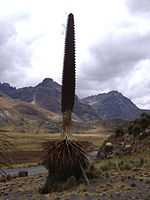Huascarán National Park
| Huascarán National Park | |
|---|---|
|
IUCN category II (national park) | |
 | |
| Location | Ancash, Peru |
| Coordinates | 9°20′0″S 77°24′0″W / 9.33333°S 77.40000°WCoordinates: 9°20′0″S 77°24′0″W / 9.33333°S 77.40000°W |
| Area | 340,000 hectares (1,300 sq mi) |
| Established | July 1, 1975 (by 622-75-AG) |
| Governing body | SERNANP |
| Type: | Natural |
| Criteria: | vii, viii |
| Designated: | 1985 (9th session) |
| Reference No. | 333 |
| State Party: | Peru |
| Region: | Latin America and the Caribbean |
Huascarán National Park (Spanish: Parque Nacional Huascarán) is a national park in the Cordillera Blanca, a range of the Andes, in Ancash of central Peru. It was also pronounced as Natural Heritage of Humanity and recognized as Reserve of Biosphere Core. The highest mountain in Peru is located in the park (also named Huascarán, reaching 6,768 meters high). This park is home to many species of animals and plants, including Puya raimondi, Cougars, Jaguars, Vicunas, the Peruvian Guemal (Hippocamelus antisensis), the Peruvian Tapir, and many species of birds.
Protected status
Its protection was initially arranged by the Peruvian government in 1975[1] in order to safeguard flora and fauna, geological formations, archaeological remains (including relics of the Chavin culture), and the panoramic scenery of the Cordillera Blanca, and to encourage scientific research into the area's natural and cultural resources. Tourism is promoted in the area, making its protected status a source of wealth for its inhabitants and others. In 1985 the park was declared a World Heritage Site by UNESCO.
Physical environment

Huascarán National Park is home to mountains ranging from 2000 to over 6000 m in height. Huascarán, the mountain from which the park takes its name, is the highest in Peru at 6768 m, and rises above nearby peaks such as Alpamayo and Pisco.
The park's 3,000 km² contain 663 glaciers, 296 lakes and 41 tributaries of three important rivers: the Santa, Pativilca and Marañón.
Climate
The climate of the park is characterized by two stages during the year. This depends on two major factors: the warm, humid winds from the Amazon Basin, which generate abundant rain between December and March; and a pronounced dry period between May and October, with sunny days that reach 25 °C and nights of intense cold during which temperatures can drop below 0°C, and well below that at higher altitudes.
Flora and fauna
The environment in the park ranges from the Sechura Desert in the west to the Peruvian Yungas in the east, with Central Andean wet puna in the higher elevations.[2] It is home to considerable biodiversity, with over 779 species of high Andean plants and 112 species of birds having been identified, including the Andean Condor (Vultur gryphus), the Torrent Duck (Merganetta armata), and the Puna Tinamou (Tinamotis pentlandii). A number of endangered birds restricted to relict Polylepis forests call the park home, such as the White-cheeked Cotinga, Plain-tailed Warbling-finch, Giant Conebill, and Tawny Tit-Spinetail. Amongst mammals, more than ten species have been observed, several of them endangered, including the Colocolo (Oncifelis colocolo), the Andean Cat (Oreailurus jacobita), the Spectacled Bear (Tremarctos ornatus), Peruvian Guemal (Hippocamelus antisensis), and the Vicuña (Vicugna vicugna).
Puya Raimondi

In the area of Catac, there are the famous Puyas Raimondi. These plants are mainly located in the spacious forests from three places of Ancash: the gully of Ingenio in Catac, the punas of Cajamarquilla and the gully of Qishqi, also in Catac.
The Puyas Raimondi was named in this way in homage to the Italian wise person who discovered it. This plant is a gigantic inflorescence that is unique all over the world. It reaches up to 10 m height, with more than three thousand flowers and six million seeds in each plant. Its biological cycle is approximately 40 years.
Activities
It is possible to walk among mountains of over 6000 m in height without being an experienced mountaineer, although there are peaks which attract the most dedicated climbers. As well as this, ecotourism, horse riding, skiing and guided archaeological excursions are all popular.
See also
- Ancash Region
- Iperu, tourist information and assistance
- Tourism in Peru
References
- ↑ SERNANP info page about Huascarán National Park (Spanish)
- ↑ Olson, D. M, E. Dinerstein, et al (2001). "Terrestrial Ecoregions of the World: A New Map of Life on Earth". BioScience 51 (11): 933–938. doi:10.1641/0006-3568(2001)051[0933:TEOTWA]2.0.CO;2.
External links
| Wikimedia Commons has media related to Huascarán National Park. |
| |||||||
| ||||||||||||||||||||||||||||||||||||||

